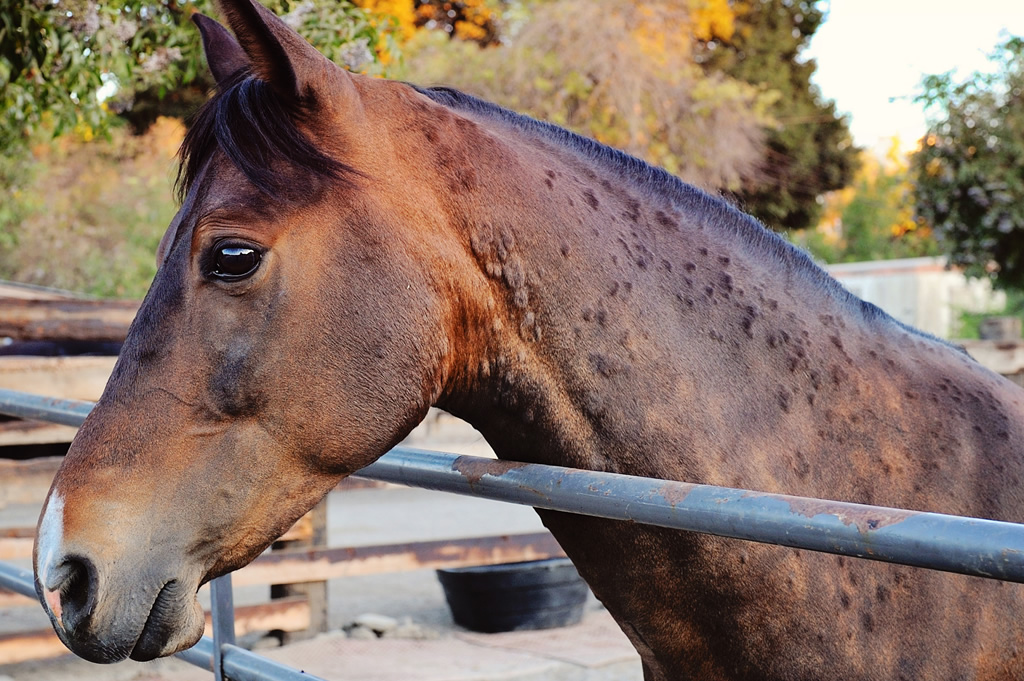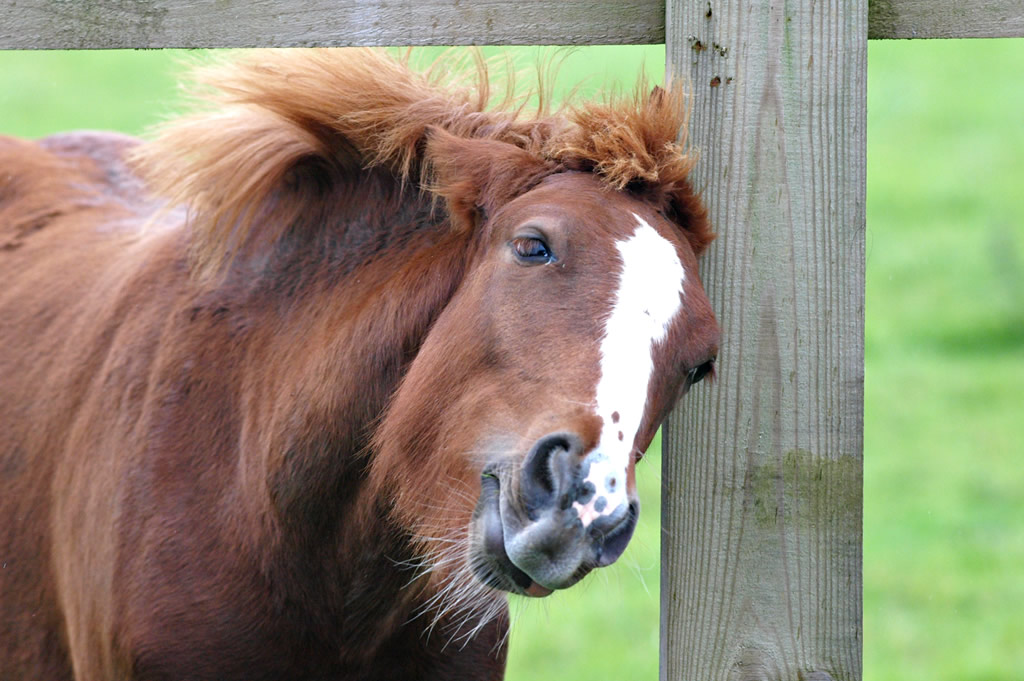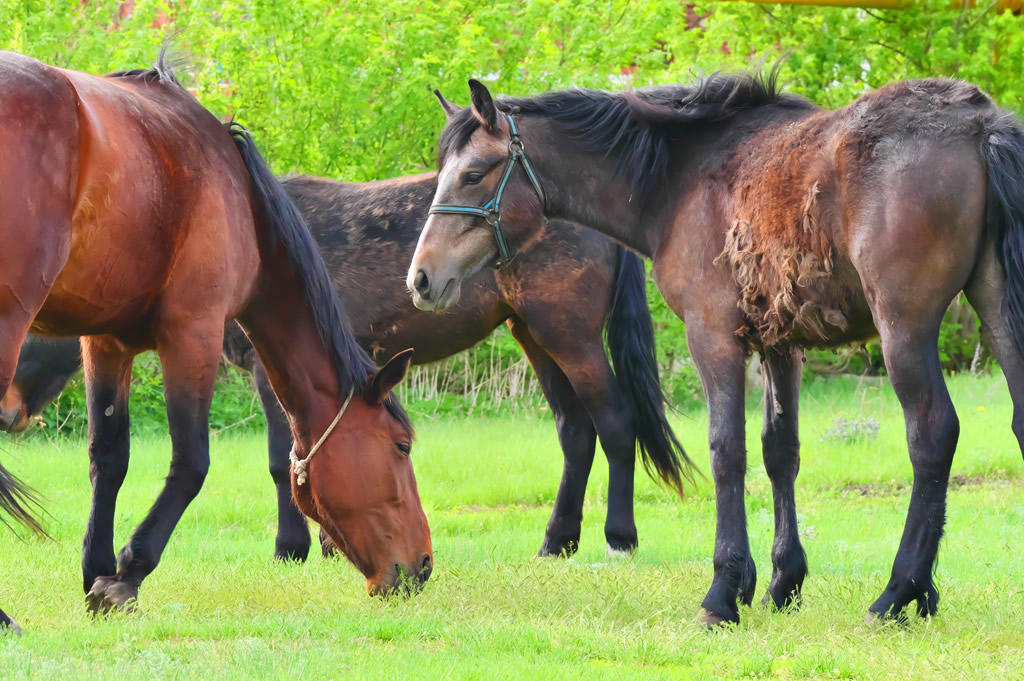Urticaria is a common skin condition that might affect your horse! Otherwise known as hives, there are many different triggers, so finding the exact cause of the problem can be difficult. At The Insurance Emporium, we’ve spoken to our horse health expert all about urticaria in horses. Find out more about the symptoms, causes and how you can help your horse if they’re suffering below!
Symptoms of urticaria

Urticaria is fairly common in horses, and can be a result of hypersensitivity to a certain trigger, like allergies. Symptoms include raised soft swellings, wheals or plaques known as hives. These sometimes have a doughnut-like shape and can appear anywhere on the body or legs, although they are most commonly found on the head and neck.
How severe are the symptoms?
Although the condition is usually not painful, it can sometimes be itchy (pruritic) for your horse and can leak fluid from the surface of the lesions. Because of this, your horse could begin itching which could cause self-trauma and secondary infections. In some cases, urticaria can have a more unusual presentation. In extreme cases, your horse could have breathing difficulties caused by the oedematous swelling.
Causes of urticaria

Urticaria often has an acute onset, and a range of factors could trigger the onset. The reaction can also occur within minutes after exposure to the trigger, or be delayed by several hours or longer. Because of this, it might not always be possible to identify the specific cause. Hives can also be mistaken for other skin conditions.
Possible triggers include:
Allergies
Urticaria (hives) is most commonly caused by an allergic reaction. This can either be something your horse has ingested, been injected with, or when the skin has come into contact with an allergen directly. There are a range of allergens which could be affecting your horse.
Insect bites
During the summer, hives can often appear as a result of insect bites or stings. This is especially common in horses that suffer with insect bite hypersensitivity (ISH), more commonly known as sweet itch. Vaccinations and medications can also cause an allergic reaction.
Ingested substances
Your horse could be allergic to a substance they have ingested. This could include feed, supplements, oral medicines or airborne substances such as pollens or chemical dusts. They could also have an allergic reaction to contaminants found in their feed or bedding, such as mould spores.
Topical medication
Some topically applied medicines, insect repellents or shampoos can trigger an allergic reaction in your horse. Other items that come into direct contact with the skin such as tack, rugs or bedding, can be responsible for urticarial reactions.
Others
Bacterial, fungal and viral infections can also be triggers, as well as parasitic infestations. Once horses have an allergic reaction, each subsequent exposure to the same allergen tends to increase the severity of the reaction. In addition, horses that are hypersensitive to one allergen are more likely to develop other allergies.
Physical & physiological
Other causes of urticaria could be physical or physiological. Stress and excitement can cause hives, as well as extremes of temperature, heavy exercising and extreme exposure to light. In addition, wheals can appear when pressure is applied to the skin, like under the saddle. These types of reactions are non-immunological.
Treatment & management

Many urticarial reactions will disappear without treatment within around 24 – 72 hours. However, if your horse remains in contact with the trigger, the condition is likely to persist or recur. The most effective way to prevent a recurrence is to remove the causative factor, or factors. Finding the causative factor can be difficult, but there are a few ways you could find it.
Process of elimination
Where possible, stagger any changes to management, administering of vaccinations, anti-parasitic or topical treatments. This should make it easier to identify the trigger should your horse have a reaction. You should also patch test before applying any topical treatments.
A process of elimination may be necessary to identify the triggers, although these can sometimes be difficult or impossible to identify. If they are identified, it may not be possible to remove them from the horse’s environment. Some infections may also be idiopathic, meaning the condition can appear spontaneously or without any known cause.
Medication
Should urticaria persist or recur in your horse, it may be necessary to manage the condition with medication. For localised lesions, a topical steroid spray or cream may be sufficient. More generalised cases may require treatment with low-dose steroids. You should be cautious with this approach, as continued use can increase the risk of laminitis. While antihistamines are often not very effective at managing the condition, they may be the treatment of choice where steroids should be avoided.
Intradermal allergy testing
Intradermal allergy testing, or IDAT, involves injecting various well-known allergens into the dermis layer of your horse’s skin. This can help identify what the horse is allergic to. An immunotherapy vaccine can then be created based on the results, which has a 60 – 70% success rate.
We hope this blog has helped if your horse is suffering! If you’re a horse owner, you might want to think about taking out insurance for your equine friend. At The Insurance Emporium, our Horse Insurance policies start with cover for Death, Theft Or Straying. Then you can customise your policy with Optional Benefits! Saddle up at The Insurance Emporium to see if we’ve got the policy for you!
All content provided on this blog is for informational purposes only. We make no representations as to the accuracy or completeness of any information on this site or found by following any link on this site. We will not be liable for any errors or omissions in this information nor for the availability of this information. We will not be liable for any loss, injury or damage arising from the display or use of this information. This policy is subject to change at any time.


